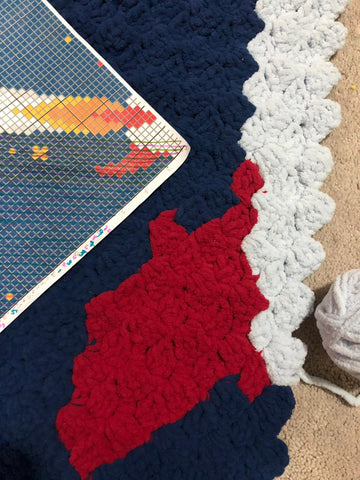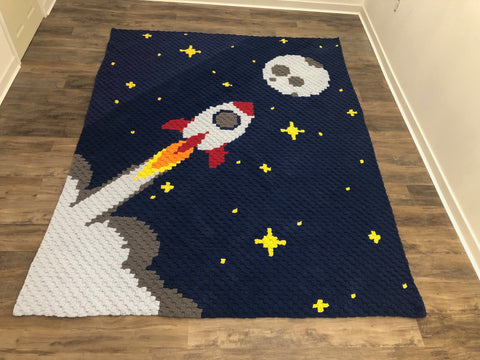C2C Blankets Tips and Tricks
When I got introduced to the concept of graph design for corner to corner blankets, it blew my mind. The possibilities are literally endless with these blankets. If you can think it, you can make it.
C2C Blankets
Corner to corner (C2C) is a crochet technique in which you crochet diagonally from one corner to the other. You can make square or rectangular blankets. Each pixel (little square) is represented by Chain 3 and 3 Double Crochets (DC).
On first sight, C2C blankets might seem hard to make. This is a common misconception resulting from the very complex designs that can be produced with this technique. In reality, it is a lot easier than you might think. The only pre-requisite is to learn how to do a DC stitch and you'll be able to crochet any design you like. Another common misconception is how much time it takes to make one of these blankets. It does not take as long as you might expect. Even though the result might make you think that it takes months to complete, the fact is you can finish one of these in about 50-60 hours. As a mother of two little boys, I like to take my time and only work a couple of hours a day after my kids go to sleep.
No matter what picture you choose the resulting blanket is something you are going to be proud of using or gifting. Every blanket you make will be unique and represents you and your passions.
For more information about the C2C techniques check out Make and Do Crew. They have done an amazing job explaining the technique in detail showing how to increase, decrease, and how to read a chart.

My first blanket
My first C2C blanket was quite an experience. I wanted to make my 3 year old a blanket. I was thinking of how cold his room is in the winter. It is located above the garage and that automatically makes it the coldest room in the house. So, why not make it with Bernat Blanket yarn. It's soft and would definitely have the warm factor I was looking for. I underestimated how different yarn can affect the size of a blanket. I ended up with a blanket 200cmx250cm (approximately 79"x98"). The shorter side is longer than me and unless you are playing for the NBA tall, it would fully cover you too. It has a great childish design but fits a super king size bed with extras. It ended up being very heavy and very warm. Even though I do not regret making it, I still have to admit it is huge.
Tips and Tricks:
- Check your left over skeins before going to buy a new one. C2C can be a good way to use some of the left over yarn you have laying around the house. Sometimes a design would have one colour in a small area.
- Keep in mind the thickness of the yarn and size of the hook before starting the yarn. It can really make a difference as you can see from my first experience.
- Using Bernat Blanket yarn and 6.5mm (K) hook will result in a 200cmx240cm (approximately 79"x98") blanket
- Using yarn 100g/361yds and 3.5 (E) hook will result in a 104cmx130cm (approximately 41"x51") blanket.
- Stay flexible when thinking about the design. In my first blanket, I was too excited and counted wrong. I ended up with the wrong shape for one of the fins of a rocket ship. I realized late, panicked and cried a little. After all, I didn't want to undo 7 whole rows in my huge blanket. My husband ended up suggesting to match the other fin to the mistake and things worked out. A little creativity with the design doesn't hurt anyone.

- To make sure my yarn didn't get tangled up, I use hair snap hair pins to hold the end of the yarn ball close to the blanket.


Picture of pins on balls of yarn
- To avoid miscounting, I like to use two different colours to mark the design indicating going up and going down. I draw a legend on the bottom of my page so I can always have a reference to which colour represented what.
- I recommend tracing one line at a time. I used to trace each 10 lines together, which lead to miscounting a lot specially when using the quarter pages. This caused me, for example, to be tracing line
- 45 on one page and mistakingly trace row 47 on the other.
- You can write the whole line pattern down instead of counting every few stitches. For example: 4 Black, 5 White, 6 Yellow, 2 Black ...
For a video showing the basic C2C techniques like: starting, increasing, decreasing, colour changing, and making a rectangle vs a square shaped blanket, check out this: http://bit.ly/2SYup5i
Please let me know about your first experience with C2C Blankets and if you have any tips and tricks you would like to share.

